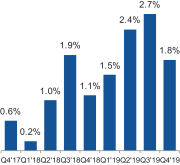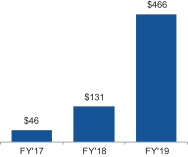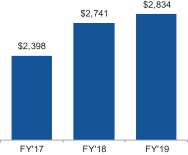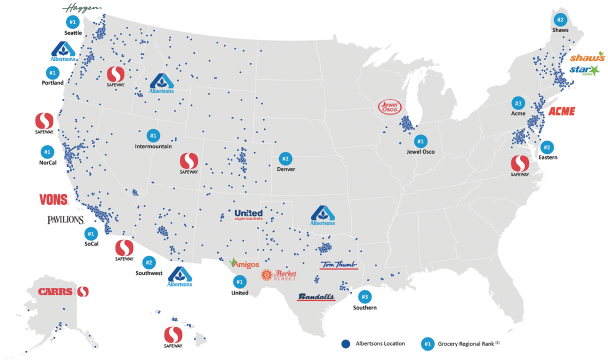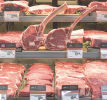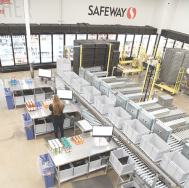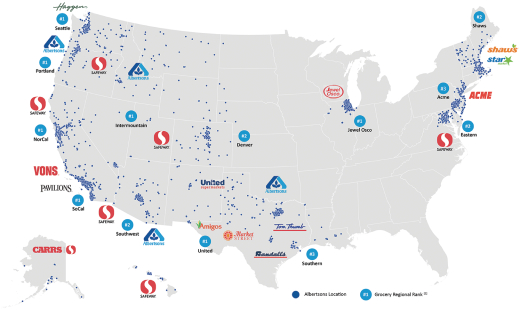Midwest Plan had assessed. On March 12, 2020, we agreed to a settlement of these matters with the Midwest Plan’s Board of Trustees. As a result of the settlement, the Company agreed to pay $75.0 million, in a lump sum, which was paid in the first quarter of fiscal 2020, and forego any amounts already paid to the Midwest Plan. The Company had previously recorded an estimated withdrawal liability and as a result of the settlement, the Company recorded a gain of $43.3 million to reduce the previously recorded estimated withdrawal liability to the settlement amount. The total amount of the withdrawal liability recorded with respect to the Dominick’s division as of February 29, 2020 was $80.0 million, which includes the $75.0 million settlement amount.
Unfavorable changes in government regulation may have a material adverse effect on our business.
Our stores are subject to various federal, state, local and foreign laws, regulations and administrative practices. We must comply with numerous provisions regulating health and sanitation standards, food labeling, energy, environmental, equal employment opportunity, minimum wages, pension, health insurance and other welfare plans, licensing for the sale of food, drugs and alcoholic beverages and any new provisions relating to the coronavirus(COVID-19) pandemic. We cannot predict either the nature of future laws, regulations, interpretations or applications, or the effect either additional governmental laws, regulations or administrative procedures, when and if promulgated, or disparate federal, state, local and foreign regulatory schemes would have on our future business. In addition, regulatory changes could require the reformulation of certain products to meet new standards, the recall or discontinuance of certain products not able to be reformulated, additional record keeping, expanded documentation of the properties of certain products, expanded or different labeling and/or scientific substantiation. Any or all of such requirements could have an adverse effect on our business.
The minimum wage continues to increase and is subject to factors outside of our control. Changes to wage regulations could have an impact on our future results of operations.
A considerable number of our employees are paid at rates related to the federal minimum wage. Additionally, many of our stores are located in states, including California, where the minimum wage is greater than the federal minimum wage and where a considerable number of employees receive compensation equal to the state’s minimum wage. For example, as of February 29, 2020, we employed approximately 67,000 associates in California, where the current minimum wage was increased to $13.00 per hour, effective January 1, 2020, and will gradually increase each year thereafter to $15.00 per hour by January 1, 2022. In Massachusetts, where we employed approximately 10,800 associates as of February 29, 2020, the minimum wage increased to $12.75 per hour, effective January 1, 2020, and will reach $15.00 per hour by 2023. In New Jersey, where we employed approximately 6,600 associates as of February 29, 2020, the minimum wage increased to $11.00 per hour, effective January 1, 2020, and will reach $15.00 per hour by 2024. In Maryland, where we employed approximately 7,100 associates as of February 29, 2020, the minimum wage increased to $11.00 per hour, effective January 1, 2020, and will reach $15.00 per hour by 2025. Moreover, municipalities may set minimum wages above the applicable state standards. For example, the minimum wage in Seattle, Washington, where we employed approximately 1,800 associates as of February 29, 2020, increased to $16.39 per hour effective January 1, 2020 for employers with more than 500 employees nationwide. In Chicago, Illinois, where we employed approximately 6,100 associates as of February 29, 2020, the minimum wage increased to $13.00 per hour effective July 1, 2019. Any further increases in the federal minimum wage or the enactment of additional state or local minimum wage increases could increase our labor costs, which may adversely affect our results of operations and financial condition.
The food retail industry is labor intensive. Our ability to meet our labor needs, while controlling wage and labor-related costs, is subject to numerous external factors, including the availability of qualified persons in the workforce in the local markets in which we are located, unemployment levels within those markets, prevailing wage rates, changing demographics, health and other insurance costs and changes in employment and labor laws. Such laws related to employee hours, wages, job classification and benefits could significantly increase operating costs. In the event of increasing wage rates, if we fail to increase our wages competitively, the quality of our
35





